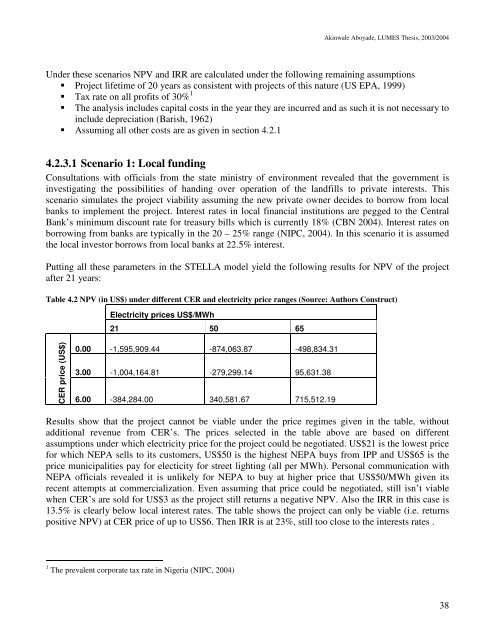Wale Aboyade's thesis - lumes
Wale Aboyade's thesis - lumes
Wale Aboyade's thesis - lumes
Create successful ePaper yourself
Turn your PDF publications into a flip-book with our unique Google optimized e-Paper software.
Akinwale Aboyade, LUMES Thesis, 2003/2004<br />
Under these scenarios NPV and IRR are calculated under the following remaining assumptions<br />
Project lifetime of 20 years as consistent with projects of this nature (US EPA, 1999)<br />
Tax rate on all profits of 30% 1<br />
The analysis includes capital costs in the year they are incurred and as such it is not necessary to<br />
include depreciation (Barish, 1962)<br />
Assuming all other costs are as given in section 4.2.1<br />
4.2.3.1 Scenario 1: Local funding<br />
Consultations with officials from the state ministry of environment revealed that the government is<br />
investigating the possibilities of handing over operation of the landfills to private interests. This<br />
scenario simulates the project viability assuming the new private owner decides to borrow from local<br />
banks to implement the project. Interest rates in local financial institutions are pegged to the Central<br />
Bank’s minimum discount rate for treasury bills which is currently 18% (CBN 2004). Interest rates on<br />
borrowing from banks are typically in the 20 – 25% range (NIPC, 2004). In this scenario it is assumed<br />
the local investor borrows from local banks at 22.5% interest.<br />
Putting all these parameters in the STELLA model yield the following results for NPV of the project<br />
after 21 years:<br />
Table 4.2 NPV (in US$) under different CER and electricity price ranges (Source: Authors Construct)<br />
Electricity prices US$/MWh<br />
21 50 65<br />
CER price (US$)<br />
0.00 -1,595,909.44 -874,063.87 -498,834.31<br />
3.00 -1,004,164.81 -279,299.14 95,631.38<br />
6.00 -384,284.00 340,581.67 715,512.19<br />
Results show that the project cannot be viable under the price regimes given in the table, without<br />
additional revenue from CER’s. The prices selected in the table above are based on different<br />
assumptions under which electricity price for the project could be negotiated. US$21 is the lowest price<br />
for which NEPA sells to its customers, US$50 is the highest NEPA buys from IPP and US$65 is the<br />
price municipalities pay for electicity for street lighting (all per MWh). Personal communication with<br />
NEPA officials revealed it is unlikely for NEPA to buy at higher price that US$50/MWh given its<br />
recent attempts at commercialization. Even assuming that price could be negotiated, still isn’t viable<br />
when CER’s are sold for US$3 as the project still returns a negative NPV. Also the IRR in this case is<br />
13.5% is clearly below local interest rates. The table shows the project can only be viable (i.e. returns<br />
positive NPV) at CER price of up to US$6. Then IRR is at 23%, still too close to the interests rates .<br />
1 The prevalent corporate tax rate in Nigeria (NIPC, 2004)<br />
38

















